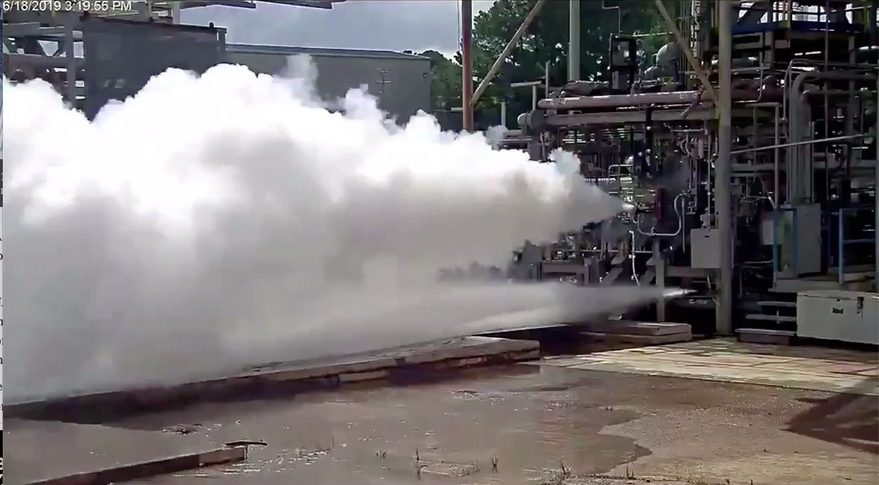Blue Origin Performs First Test of BE-7 Lunar Lander Engine

WASHINGTON — Blue Origin has performed the first hotfire test of the engine it plans to use on its Blue Moon lunar lander.
Company founder Jeff Bezos tweeted June 19 that the test of the BE-7 engine took place the previous day at NASA’s Marshall Space Flight Center. The 35-second test went as expected, he said. "Data looks great and hardware is in perfect condition," he wrote in the post, which included a video of the test.
First hotfire of our #BE7 lunar landing engine just yesterday at Marshall Space Flight Center. Data looks great and hardware is in perfect condition. Test went full planned duration – 35 seconds. Kudos to the whole @BlueOrigin team and grateful to @NASA_Marshall for all the help! pic.twitter.com/cTjjrngumYJune 20, 2019
The company announced the BE-7 engine during a May 9 event here where Bezos unveiled the updated design of the company’s Blue Moon lander. That lander will be able to carry 3.6 metric tons of cargo to the lunar surface, with a "stretch tank" version increasing that capacity to 6.5 metric tons. That larger version of the lander could also carry an ascent stage to enable crewed missions to the lunar surface.
Related: Here's How Blue Origin's New Lunar Lander Works
Blue Moon will be powered by a single BE-7 engine, capable of producing 10,000 pounds-force of thrust and deeply throttleable. The engine uses liquid oxygen and liquid hydrogen propellants, leveraging the company’s experience on the larger BE-3 engine used on its New Shepard suborbital vehicle and upper stage of its New Glenn orbital rocket.
At the May event, Bezos said the company selected liquid hydrogen and liquid oxygen for the BE-7 because of their high performance. In addition, it allows the lander to potentially make use of in situ resources on the moon in the form of water ice that could be converted into hydrogen and oxygen. "Ultimately, we're going to be able to get hydrogen from that water on the moon, and be able to refuel these vehicles on the surface of the moon," he said then.
"We've been working on this for three years," he said at the event. "We’re going to hot fire it for the first time this summer. The only reason we can do that is we’ve been working on it for three years."
Get the Space.com Newsletter
Breaking space news, the latest updates on rocket launches, skywatching events and more!
Bezos tweeted about the test shortly after he appeared at a "Space Summit" June 19 held at the John F. Kennedy Library in Boston. Interviewed on stage by Caroline Kennedy, Bezos didn't mention the test but did briefly discuss the lander, including the decision to use liquid oxygen and liquid hydrogen. "One day, we'll be refueling that vehicle on the surface of the moon from propellants made on the moon from that water ice," he said.
"Okay," Kennedy responded after a pause.
Bezos used that appearance to critique government's role in space. He said that, on the one hand, the government is needed to enable a human return to the moon, with partners like Blue Origin. "It's going to be difficult to put humans on the moon without government support," he said. "It's expensive, we need government facilities to do it, we need government know-how do it."
"It has to be a team effort," he continued. "It will be many companies, not just Blue Origin. It will be collaborative."
Blue Origin is already working with NASA on the agency's plans to return humans to the surface of the moon. The company was one of 11 that received contracts from NASA May 16 for studies and initial prototype development of lunar lander descent stages and transfer vehicles. The company is expected to participate in a separate call for proposals later this year for work on integrated lunar lander systems.
Bezos, though, was also critical of how government space programs have been historically run. "A lot of the big government programs get very protected by members of Congress," he said. "Big NASA programs become seen as jobs programs, and that they have to be distributed to the right states where the right senators live, and so on."
That approach, he said, will "change the objective" of such programs. "Now your objective is not to get a man to the moon or a woman to the moon but, instead, to get a woman to the moon while preserving X number of jobs in my district. That is a 'complexifier' and not a healthy one."
"If I were a senior official at NASA, I would be very frustrated from time to time," he said. Among those in attendance at the event was former NASA Administrator Charles Bolden, who appeared on a panel earlier in the day. "Charlie, don't say a word," Bezos said. "But he's smiling, let the record reflect."
- Blue Origin's Lunar Lander: A Photo Tour
- NASA Awards $45.5 Million for Private Moon Lander Work on Project Artemis
- Lockheed Martin Proposes 'Early Gateway' to Put Astronauts on the Moon by 2024
This story was provided by SpaceNews, dedicated to covering all aspects of the space industry.
Join our Space Forums to keep talking space on the latest missions, night sky and more! And if you have a news tip, correction or comment, let us know at: community@space.com.

Jeff Foust is a Senior Staff Writer at SpaceNews, a space industry news magazine and website, where he writes about space policy, commercial spaceflight and other aerospace industry topics. Jeff has a Ph.D. in planetary sciences from the Massachusetts Institute of Technology and earned a bachelor's degree in geophysics and planetary science from the California Institute of Technology. You can see Jeff's latest projects by following him on Twitter.










